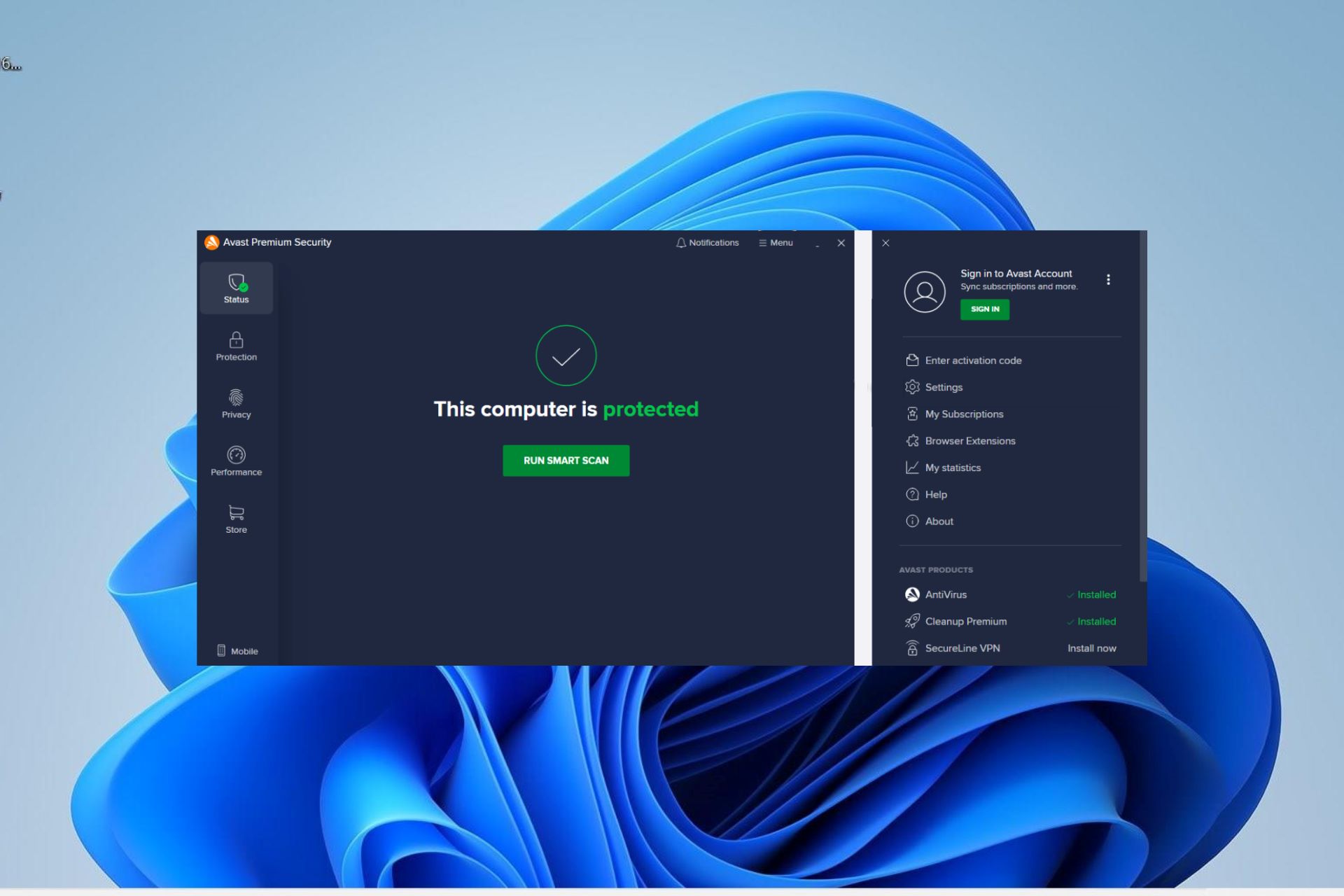Introduction
Welcome to an exploration of why Avast, one of the most popular antivirus software programs, might be taking up a significant amount of CPU usage on your computer. Understanding this issue is crucial, as excessive CPU usage can slow down your system, impairing its overall performance. In this article, we will dive into the reasons behind this, as well as provide you with some solutions to alleviate the issue.
Avast is a robust antivirus program that offers real-time protection against malware, spyware, and other potential threats. It is known for its comprehensive scanning capabilities and frequent updates to ensure your computer remains safe and secure.
However, despite its benefits, some users have reported that Avast tends to consume a significant portion of their CPU resources, leading to a slowdown in their system performance.
Before we delve into the possible reasons behind Avast’s high CPU usage, let’s first understand the crucial role the CPU plays in the operation of your computer.
The CPU (Central Processing Unit) is the brain of your computer. It executes instructions and carries out calculations, allowing your computer to perform various tasks. When an application, such as Avast, uses a substantial amount of CPU resources, it diverts the CPU’s attention from other essential tasks, potentially causing lag and decreased responsiveness.
Now that we have a basic understanding of Avast and CPU usage, let’s explore some potential factors contributing to Avast’s high CPU usage, as well as strategies to mitigate this issue.
What is Avast?
Avast is a widely recognized antivirus program developed by Avast Software. It offers comprehensive protection against various forms of malware, including viruses, worms, spyware, ransomware, and more. Avast’s reputation as a reliable and effective antivirus solution has made it a popular choice among millions of users worldwide.
The primary function of Avast is to scan your computer for potential threats and remove them to ensure the security of your system. It employs advanced algorithms and heuristic analysis to detect and block suspicious files and websites in real-time, providing you with a proactive defense against emerging threats.
Avast comes with a range of features and tools that enhance its functionality and usability. Some notable features include:
- Real-time Protection: Avast continuously monitors your system, scanning files and processes in real-time to detect and block any potential threats.
- Web Protection: Avast offers a web shield that scans websites for malicious content, protecting you from phishing attacks, malware-hosting sites, and other online threats.
- Behavior Shield: This feature analyzes the behavior of applications and processes running on your computer, identifying any suspicious or malicious activities.
- Firewall: Avast includes a built-in firewall that safeguards your network connections, preventing unauthorized access and protecting your sensitive data.
- Wi-Fi Inspector: Avast’s Wi-Fi Inspector scans your network for vulnerabilities, ensuring your Wi-Fi connection is secure and protected from intruders.
Avast also offers various customization options, allowing users to tailor the antivirus program according to their specific needs. You can choose between different scan types, configure automatic updates, set scan schedules, and adjust the level of protection based on your preferences.
Overall, Avast plays a vital role in safeguarding your computer and personal information from malware and cyber threats. However, it’s essential to keep in mind that, like any other software, Avast may encounter certain issues that can affect its performance, such as high CPU usage.
CPU Usage and its Importance
CPU usage refers to the percentage of the CPU’s processing capacity that is being utilized by a specific program or process at any given time. It is an essential metric in determining the overall performance of your computer. Understanding CPU usage is crucial because it directly impacts the speed and efficiency of your system.
The CPU serves as the central hub for all processing tasks on your computer. It executes instructions, performs calculations, and manages the flow of data between different components of your computer. Every action you take on your computer, from opening a program to browsing the internet, requires CPU utilization.
When a program, such as Avast, utilizes a significant portion of the CPU’s resources, it can monopolize the processing power, resulting in high CPU usage. This can cause your computer to slow down, freeze, or become unresponsive, negatively impacting your productivity and overall user experience.
Monitoring CPU usage is crucial for several reasons:
- Performance Optimization: By monitoring CPU usage, you can identify processes or applications that are consuming excessive resources. This allows you to optimize your system’s performance by either closing unnecessary programs or resolving any underlying issues causing high CPU usage.
- Troubleshooting: High CPU usage can be an indication of a problem, such as a virus or malware infection, a faulty hardware component, or conflicting software. Monitoring CPU usage helps to identify the source of the issue, allowing for effective troubleshooting and resolution.
- Resource Management: By understanding CPU usage, you can allocate resources effectively. For instance, if you are running resource-intensive applications or tasks, you can prioritize them and ensure that they receive the necessary processing power to function smoothly.
- System Stability: High CPU usage can lead to system instability, including crashes, freezes, and errors. By monitoring CPU usage, you can proactively address and prevent these issues, ensuring the stability and reliability of your computer.
Optimizing CPU usage is essential for maintaining a smooth and efficient computing experience. In the next sections, we will explore the potential reasons behind Avast’s high CPU usage and provide solutions to mitigate this issue.
Reasons why Avast may be causing high CPU usage
If you have noticed that Avast is causing high CPU usage on your computer, there are several potential reasons that could be contributing to this issue. Understanding these reasons can help you resolve the problem and restore the smooth operation of your system.
Here are some common factors that may cause Avast’s high CPU usage:
- Lack of system resources: Avast, like any other antivirus program, requires system resources to function effectively. If your computer has limited RAM or processing power, Avast’s continuous scanning and monitoring processes can overload the CPU, resulting in high CPU usage.
- Outdated Avast version: An outdated or unpatched version of Avast may contain bugs or performance issues that could lead to high CPU usage. It is important to keep your Avast software up-to-date by regularly installing the latest updates and patches provided by the manufacturer.
- Conflicts with other programs: Sometimes, Avast may interfere with other applications or software installed on your computer, resulting in increased CPU usage. Incompatible software or conflicting antivirus programs can trigger resource conflicts, leading to higher CPU usage.
- Heavy scanning or other tasks running in the background: Avast performs various scanning tasks in the background to ensure real-time protection against threats. If Avast is conducting a deep or full system scan, it can consume a significant amount of CPU resources and temporarily increase CPU usage.
Identifying the specific reason causing high CPU usage in Avast requires a systematic troubleshooting approach. Consider the following actions to mitigate the issue:
- Close unnecessary programs: Close any programs and applications that are not in use. This frees up CPU resources and reduces the overall CPU usage.
- Upgrade your hardware: If your computer’s hardware is outdated or insufficient, consider upgrading your RAM or CPU to provide better performance and handle the resource demands of Avast.
- Update Avast: Ensure that you are using the latest version of Avast antivirus software. Check for updates regularly and install any available patches to address performance-related issues.
- Check for conflicting software: Review your system for other antivirus or security software that may be running alongside Avast. Uninstall any conflicting programs to prevent resource conflicts.
- Adjust Avast settings: Within the Avast interface, navigate to the settings and modify the scan options. Opt for more lightweight scanning methods, such as quick scans, to reduce CPU usage.
By addressing these potential factors and taking the necessary steps, you can effectively troubleshoot and alleviate high CPU usage caused by Avast.
In the next section, we will discuss further strategies on how to reduce Avast’s CPU usage and maintain a balanced performance between system security and overall computing experience.
Lack of system resources
One of the potential reasons behind Avast’s high CPU usage is the lack of sufficient system resources on your computer. Avast, like any other antivirus program, requires a certain amount of RAM and processing power to carry out its scanning and monitoring tasks effectively. If your computer has limited resources, Avast’s resource-intensive operations can overload the CPU, leading to high CPU usage and a slowdown in overall system performance.
Here are some factors related to system resources that can contribute to Avast’s high CPU usage:
- Insufficient RAM: Random Access Memory (RAM) is temporary storage that your computer uses to hold data and instructions. Inadequate RAM can constrain the number of programs and processes that your computer can handle simultaneously, causing excessive strain on the CPU when running Avast.
- Inadequate processing power: If your CPU has lower processing power or is outdated, it may struggle to handle the scanning and monitoring tasks performed by Avast. This can result in increased CPU usage as it tries to compensate for the performance limitations.
- Running multiple resource-intensive applications: When you have several resource-intensive applications running concurrently, such as video editing software or games, it can put a significant strain on the CPU. Adding Avast’s scanning processes to the mix can further increase CPU usage and lead to performance issues.
To address high CPU usage caused by a lack of system resources, consider the following strategies:
- Upgrade your RAM: Increasing the amount of RAM in your computer can provide more space for Avast and other applications to operate without overwhelming the CPU. Check your computer’s specifications and consider upgrading the RAM if it falls below the recommended requirements for running Avast smoothly.
- Upgrade your CPU: If you have an older or less powerful CPU, it may struggle to handle Avast’s resource demands. Upgrading to a faster or newer CPU can improve overall system performance and alleviate high CPU usage caused by Avast.
- Close unnecessary applications: Before running Avast, close any unnecessary applications and processes that are consuming CPU resources. This frees up CPU power and allows Avast to function more efficiently.
- Optimize Avast settings: Within the Avast program, adjust the settings to optimize CPU usage. For example, you can modify the scan frequency, exclude certain files or folders from scans, or schedule scans during periods of lower computer usage.
- Consider a lightweight antivirus solution: If your computer consistently struggles with Avast’s high CPU usage, you may want to explore alternative antivirus programs that have lower resource requirements. Look for reputable antivirus software specifically designed to operate efficiently on systems with limited resources.
By addressing the lack of system resources and implementing these strategies, you can effectively reduce Avast’s CPU usage and improve the overall performance of your computer.
Outdated Avast version
Using an outdated or unpatched version of Avast antivirus software can contribute to high CPU usage. Updates and patches provided by Avast are essential for fixing bugs, improving performance, and addressing known issues. If you are running an outdated version of Avast, it may contain performance-related bugs or vulnerabilities that could result in increased CPU usage.
Here are the potential consequences of using an outdated Avast version:
- Bugs and performance issues: Outdated versions of Avast may contain bugs or programming errors that can cause erratic behavior, including high CPU usage. Updates often include bug fixes and performance optimizations to ensure smoother operation and minimize resource consumption.
- Security vulnerabilities: Cyber threats are constantly evolving, and antivirus software needs to keep up with them. Outdated versions of Avast may lack the latest security patches, potentially leaving your system exposed to new threats. These vulnerabilities can complicate Avast’s scanning and monitoring processes, leading to higher CPU usage.
- Incompatibility with the operating system: As operating systems evolve, software developers update their programs to maintain compatibility. An outdated Avast version may not be fully compatible with the latest updates of your operating system, causing conflicts and affecting CPU usage.
To mitigate high CPU usage caused by an outdated Avast version, follow these steps:
- Check for updates: Open the Avast program and navigate to the settings. Look for an option to check for updates manually. If an update is available, proceed with the installation to ensure you are running the latest version.
- Enable automatic updates: Configure Avast to automatically check and install updates. This ensures that you receive the latest bug fixes, performance enhancements, and security patches without manual intervention.
- Reinstall Avast: If you are experiencing consistent high CPU usage even after updating, consider a fresh reinstall of Avast. This can help address any underlying issues that might have occurred during the update process.
- Keep your operating system updated: Ensure that your operating system is also up-to-date with the latest security patches and updates. This helps maintain compatibility with Avast and reduces the risk of conflicts that can lead to high CPU usage.
- Consider a clean installation: If updating or reinstalling Avast does not resolve the high CPU usage issue, you may want to perform a clean installation of the latest version. This involves uninstalling the existing Avast installation, removing any leftover files, and then installing Avast from scratch.
By keeping Avast up-to-date and addressing any potential issues related to outdated software, you can minimize high CPU usage and ensure optimal performance from the antivirus program.
Conflicts with other programs
Avast’s high CPU usage can sometimes be attributed to conflicts with other software or applications installed on your computer. Incompatibilities or interactions between Avast and certain programs can lead to increased CPU usage and system slowdowns. Identifying and resolving these conflicts is crucial to ensure smooth operation and minimize resource consumption.
Here are some potential causes of conflicts between Avast and other programs:
- Incompatible antivirus or security software: Running multiple antivirus or security programs simultaneously can lead to conflicts and increased CPU usage. Different security applications may try to perform similar tasks, such as real-time scanning or firewall protection, which can result in resource conflicts.
- Software compatibility issues: Certain applications may have compatibility issues with Avast due to differences in programming or resource requirements. Conflicts can arise when these applications try to access or modify system resources simultaneously, impacting CPU usage.
- Third-party browser extensions or plugins: Some browser extensions or plugins, particularly those related to security or privacy, can conflict with Avast’s browser protection features. This may lead to increased CPU usage when browsing the internet.
- Background processes or services: Some system processes or services may interfere with Avast’s operations, causing conflicts and high CPU usage. These conflicts can occur if the processes are resource-intensive or if they access the same files or system components as Avast.
To resolve conflicts between Avast and other programs, consider the following actions:
- Uninstall conflicting software: Identify any antivirus or security software that may be running alongside Avast and uninstall it. Running multiple security programs simultaneously is unnecessary and can cause conflicts, leading to increased CPU usage.
- Disable or remove conflicting browser extensions or plugins: If you suspect that certain browser extensions or plugins are conflicting with Avast, disable or remove them. Test the system to observe if the CPU usage decreases after doing so.
- Update or reinstall problematic software: If you have identified specific software that conflicts with Avast, check for updates or reinstall the program to ensure compatibility and minimize conflicts.
- Adjust Avast settings: Within the Avast interface, navigate to the settings and explore options related to compatibility or conflicts. Modify these settings to prevent or minimize conflicts with other programs.
- Perform a clean boot: A clean boot allows you to start your computer with a minimal set of startup programs and services, reducing the chance of conflicts between Avast and other applications. This can help isolate the source of the conflict and identify which program is causing the high CPU usage.
By troubleshooting and resolving conflicts between Avast and other programs, you can effectively reduce high CPU usage and ensure smooth operation of both Avast and the conflicting software.
Heavy scanning or other tasks running in the background
If Avast is conducting a heavy scanning process or if there are other resource-intensive tasks running in the background, it can significantly contribute to high CPU usage. These resource-consuming operations can overload the CPU, leading to a slowdown in system performance and increased CPU usage.
Here are some scenarios that may cause heavy scanning or other tasks running in the background:
- Deep or full system scans: Avast offers comprehensive scanning options to ensure thorough detection of malware and other threats. Deep or full system scans can be resource-intensive as Avast examines every file and folder in your computer, potentially increasing CPU usage.
- Updating virus definitions: Avast frequently updates its virus definitions to stay up-to-date with the latest threats. When Avast is updating its virus database, it may consume additional CPU resources as it downloads, verifies, and integrates the updated definitions into the scanning process.
- Background tasks: Avast performs various background tasks to provide real-time protection, such as scanning downloaded files, monitoring network activity, or analyzing the behavior of running processes. These continuous background tasks can contribute to increased CPU usage if multiple resource-intensive operations are running simultaneously.
- Resource-demanding applications: If you have other resource-intensive applications running concurrently with Avast, such as video editing software, gaming, or running virtual machines, the combined resource consumption can lead to higher CPU usage.
To reduce high CPU usage caused by heavy scanning or other resource-intensive tasks in Avast, consider implementing the following strategies:
- Adjust scan settings: Within Avast’s settings, customize the scan options to perform lighter scans, such as quick scans, instead of deep or full system scans. This reduces the scan’s impact on CPU usage while still providing adequate protection.
- Schedule scans during periods of low computer usage: Set up a scan schedule in Avast to run during times when you are not actively using your computer. This allows the scans to occur without interrupting your regular tasks or causing noticeable performance drops.
- Limit background tasks: Review Avast’s background tasks or features and disable any unnecessary ones that may consume significant CPU resources. Focus on disabling features that are less critical for your specific needs or that are causing high CPU usage.
- Close resource-demanding applications: Reduce the number of resource-intensive applications running alongside Avast. Closing unused applications frees up CPU resources and reduces overall CPU usage.
By adjusting Avast’s settings and managing background tasks effectively, you can minimize high CPU usage caused by heavy scanning or other resource-intensive processes, ensuring smoother system performance.
How to reduce Avast CPU usage
If you are experiencing high CPU usage caused by Avast, there are several steps you can take to mitigate the issue and optimize the performance of the antivirus software. By implementing the following strategies, you can reduce Avast’s CPU usage and ensure a smoother overall computing experience.
- Update Avast: Ensure that you have the latest version of Avast installed on your computer. Regularly check for updates and install them to benefit from bug fixes, performance improvements, and security patches that can help reduce CPU usage.
- Adjust scan settings: Within Avast’s settings, customize the scanning options to minimize CPU usage. Consider running lighter scans, such as quick scans, rather than deep or full system scans, especially if you have limited system resources.
- Optimize background tasks: Review Avast’s background tasks and disable any unnecessary processes that are consuming CPU resources. Focus on disabling features that are not critical for your specific needs or are causing high CPU usage.
- Limit real-time protection: While real-time protection is vital for keeping your system secure, reducing its intensity can help alleviate CPU usage. Adjust the real-time scanning options in Avast to strike a balance between effective protection and CPU resource consumption.
- Exclude trusted files and folders: Avast allows you to exclude specific files, folders, or even entire drives from being scanned. Exclude trusted items that do not require scanning to minimize unnecessary CPU usage.
- Manage startup programs: Review the programs that automatically launch when your computer starts up. Disable any unnecessary startup programs to reduce the overall CPU load and optimize system performance.
- Close resource-intensive applications: If you have other resource-intensive applications running alongside Avast, consider closing them when not in use. Reducing the overall CPU load will help decrease the strain on your system.
- Consider alternative antivirus software: If you consistently experience high CPU usage with Avast despite trying these optimization techniques, you may want to explore alternative antivirus programs that have lower resource requirements. Look for reputable antivirus software that balances performance and security effectively.
By implementing these strategies, you can effectively reduce Avast’s CPU usage and improve your computer’s overall performance. It’s important to strike a balance between system security and CPU resource allocation to ensure a seamless and efficient computing experience.
Conclusion
In conclusion, high CPU usage caused by Avast can be an inconvenience, causing system slowdowns and impairing overall computer performance. However, by understanding the potential reasons behind the high CPU usage and implementing the suggested solutions, you can effectively reduce the strain on your CPU and optimize Avast’s performance.
We explored various factors that can contribute to Avast’s high CPU usage, including a lack of system resources, outdated Avast versions, conflicts with other programs, and heavy scanning or other resource-intensive tasks running in the background. By addressing these factors, such as upgrading hardware components, installing updates, resolving conflicts, and managing background tasks, you can reduce Avast’s CPU usage.
Additionally, we provided strategies to help minimize Avast’s CPU usage, including adjusting scan settings, optimizing background tasks, limiting real-time protection, and carefully managing startup programs. These steps strike a balance between effective system security and efficient CPU resource allocation.
Remember, regular maintenance of your system, including updating Avast and keeping your operating system up-to-date, is crucial for optimal performance and security. By adopting these practices, you can ensure that Avast functions smoothly, without consuming excessive CPU resources.
If you continue to experience high CPU usage with Avast despite implementing these strategies, consider contacting Avast’s support for further assistance. They can provide tailored recommendations based on your specific situation.
Ultimately, reducing Avast’s CPU usage requires a combination of optimizing settings, managing resources, and maintaining an up-to-date system. With these measures in place, you can enjoy the benefits of Avast’s robust security features while maintaining the performance of your computer.

























